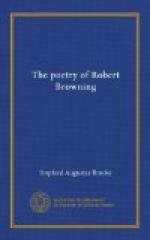I let Lisa go, and what good in life since?
Flower of the thyme—and so on. Round they went.
Scarce had they turned the corner when a titter,
Like the skipping of rabbits by moonlight,—three slim shapes,
And a face that looked up ... zooks, sir, flesh and blood,
That’s all I’m made of! Into shreds it went,
Curtain and counterpane and coverlet,
All the bed furniture—a dozen knots,
There was a ladder! Down I let myself,
Hands and feet, scrambling somehow, and so dropped,
And after them. I came up with the fun
Hard by St. Laurence, hail fellow, well met,—
Flower o’ the rose,
If I’ve been merry, what matter who knows?
It is a picture, not only of the man, but of the time and its temper, when religion and morality, as well as that simplicity of life which Dante describes, had lost their ancient power over society in Florence; when the claim to give to human nature all it desired had stolen into the Church itself. Even in the monasteries, the long seclusion from natural human life had produced a reaction, which soon, indulging itself as Fra Lippo Lippi did, ran into an extremity of licence. Nevertheless, something of the old religious life lasted at the time of this poem. It stretched one hand back to the piety of the past, and retained, though faith and devotion had left them, its observances and conventions; so that, at first, when Lippo was painting, the new only peeped out of the old, like the saucy face of a nymph from the ilexes of a sacred grove. This is the historical moment Browning illustrates. Lippo Lippi was forced to paint the worn religious subjects: Jerome knocking his breast, the choirs of angels and martyrs, the scenes of the Gospel; but out of all he did the eager modern life began to glance! Natural, quaint, original faces and attitudes appeared; the angels smiled like Florentine women; the saints wore the air of Bohemians. There is a picture by Lippo Lippi in the National Gallery of some nine of them sitting on a bench under a hedge of roses, and it is no paradox to say that they might fairly represent the Florentines who tell the tales of the Decameron.
The transition as it appeared in art is drawn in this poem. Lippo Lippi became a monk by chance; it was not his vocation. A starving boy, he roamed the streets of Florence; and the widespread intelligence of the city is marked by Browning’s account of the way in which the boy observed all the life of the streets for eight years. Then the coming change of the aims of art is indicated by the way in which, when he was allowed to paint, he covered the walls of the Carmine, not with saints, virgins, and angels, but with the daily life of the streets—the boy patting the dog, the murderer taking refuge at the altar, the white wrath of the avenger coming up




